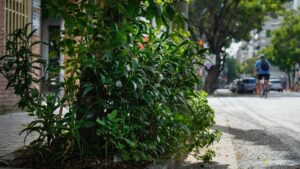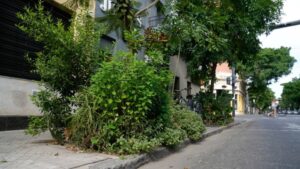Urban tree planting has become a key element to mitigate the impact of “heat islands” in cities, as well as improve quality of life and promote sustainability. Rosario, recognized for its environmental commitment, is promoting an ambitious comprehensive tree management plan that includes planting 80,000 new specimens between 2024 and 2027, with a focus on native species.
Rosario has approximately 420,000 trees in public green spaces and sidewalks, standing out as the greenest city in Argentina according to a study by the Inter-American Development Bank (IDB). With an average of 12 square meters of green areas per inhabitant, the city significantly surpasses other urban areas in the country, such as Buenos Aires.
The concept of “garden city”, which seeks to integrate nature and urban planning, guides many local policies. Since 2023, regulations promote “garden sidewalks” with absorbent areas and vegetation coverage, ensuring space for at least one tree per plot in new constructions.

Ongoing Projects
During 2024, 3,000 tree pits were expanded in different neighborhoods such as Abasto, Pichincha, and Bella Vista. This work not only improves root development and water absorption but also includes the planting of complementary plants in available spaces.
Additionally, the nursery at the Bosque de los Constituyentes is a key element in this effort, producing 2,500 trees annually from over 70 species, including jacarandas, lapachos, and ash trees, which are then integrated into public spaces.
Environmental and Social Benefits of Urban Tree Planting
Urban tree planting not only beautifies the streets but also reduces ambient temperature by 2 to 8 degrees, improves air quality by capturing pollutant particles, and acts as a sound barrier. It also contributes to stormwater drainage, intercepting up to 15,000 liters per tree per year, preventing floods and reducing drain collapses.
According to Damián Verzeñassi, director of the Institute of Socio-Environmental Health at UNR, living surrounded by public trees reduces stress, enhances cognitive capacity, and decreases irritability due to urban noise.
Challenges and Future Plans
The main challenge lies in preserving and expanding existing tree planting. By 2025, Rosario will conduct a new census of alignment trees, assessing the phytosanitary status and distribution of specimens. The Tree Committee, composed of experts and organizations, leads this initiative and aims to establish itself as a space for planning and supervision.
More than just aesthetics, tree planting is an investment in health, sustainability, and quality of life. Its care requires ongoing efforts, from ensuring irrigation to promoting citizen participation in its defense. In Verzeñassi’s words: “Urban tree planting is not just a landscaping resource, but an essential tool for building resilient and healthy cities.”
 The benefits of urban tree planting. Photo: rosario3.[/caption>
The benefits of urban tree planting. Photo: rosario3.[/caption>
Green areas, the best allies against climate change
In addition to reducing air temperature by 2 to 8 °C, the location of green spaces and trees can help decrease air conditioning usage by 30%.
In this sense, urban trees become great allies in combating climate change. Therefore, it is important to care for and protect them, as they are beneficial for the planet.
Have you visited our YouTube channel yet? Subscribe now!

